TPE: Emblem 2
ICONOLOGY. Learning to capture the identifying gesture and attributes of the wide image in an emblem has as relay an ancient tradition.
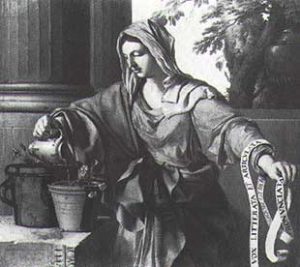 This pictorial tradition can be traced back to an engraving by Marc Antonio. It shows an almost naked woman of Giorgionesque type watering a flower. This enigmatic motif can be explained with the help of the literary tradition. It is a symbol of “Grammatica.” As the plant grows through watering so the young mind is formed through the study of grammar. In late antiquity grammar became the foundation of the liberal arts. This pictorial tradition can be traced back to an engraving by Marc Antonio. It shows an almost naked woman of Giorgionesque type watering a flower. This enigmatic motif can be explained with the help of the literary tradition. It is a symbol of “Grammatica.” As the plant grows through watering so the young mind is formed through the study of grammar. In late antiquity grammar became the foundation of the liberal arts.Rudolf Wittkower, Allegory and the Migration of Symbols, Thames and Hudson, 1977.Wittkower inventories some of the related features associated with Grammar in her allegorical representations: “an old woman carrying a vessel which is supposed to contain medicine for correcting the children’s pronunciation and a knife for sharpening their defective tongues. She also holds a file, with which the grammatical mistakes can be removed.” Ultimately, the watering of the flower became the chief motif of the allegory. |
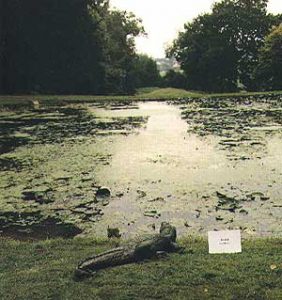
_________
–Artist Appropriations.With the renewed interest in allegory associated with postmodernism, contemporary artists have brought photography to bear on the tradition of iconology, as in this work.
“The Tears of Concupiscence”
from the series Imprese by Olivier Richon
Other Than Itself: Writing Photography Eds. John X. Berger and Olivier Richon, Cornerhouse Publications, 1989.
How would you picture “ardent, sensuous longing” (lust)?
–From the Archive:
Here is one example of an emblem, taken from Geffrey Whitney’s Choice of Emblemes, published in Leiden by Christopher Plantin in 1586. It is the first full-fledged English emblem book in the continental style, and uses woodblocks from a number of other emblem books, the most important of which is Alciato’s Emblematum liber. (www.mun.ca/alciato/wcomm.html)
Dissidia inter aequales, pessima
(Disputes among equals are the worst)
The Swallowe swifte, dothe beare unto her neste The Grasshopper, that did no daunger feare, For that shee thought, the lov'de togeather beste, Bycause they both, observ'de one time of yeare, And bothe, did joye theire jarring notes to sounde, And neare the house they bothe, theire dwellings founde. Yet time, and tune, and neighbourhood forgotte, For perfect frende, a tyrant shee became, Which taxeth those, whome God dothe heare allotte Like gifts of grace, to winne a lasting name, Yet Envie soe theire vertues doth deface, It makes them foes, to them theie should imbrace.


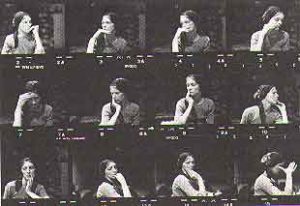
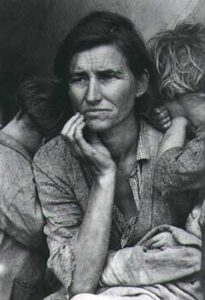 Nancy Kitchel’s “grandmother’s gesture” may be seen as a series of variations on a gesture of worry and anxiety codified in this photograph taken by Dorothea Lange as part of a New Deal project to document the misery of migrant workers, sponsored by the Farm Security Administration during the Great Depression. “Migrant Mother” is one of the most-cited pictorial images of our times.
Nancy Kitchel’s “grandmother’s gesture” may be seen as a series of variations on a gesture of worry and anxiety codified in this photograph taken by Dorothea Lange as part of a New Deal project to document the misery of migrant workers, sponsored by the Farm Security Administration during the Great Depression. “Migrant Mother” is one of the most-cited pictorial images of our times.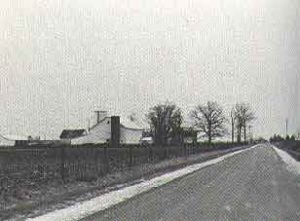 This idea I have that the whole inside of my head resembles this landscape (flat? nothing there?), that the particular, peculiar sense of great space, isolation in space, harshness, clarity, severity, the constant transitions, shifts, reveries, the wild swings form one state to another, forms the visual, auditory, reasoning, base for thought or action. A sense that I have been formed out of the quality of the landscape, that everything unnecessary is being slowly eroded by harsher elements. And the confidence that I will survive, denuded, or that something will survive, something will never stop.”
This idea I have that the whole inside of my head resembles this landscape (flat? nothing there?), that the particular, peculiar sense of great space, isolation in space, harshness, clarity, severity, the constant transitions, shifts, reveries, the wild swings form one state to another, forms the visual, auditory, reasoning, base for thought or action. A sense that I have been formed out of the quality of the landscape, that everything unnecessary is being slowly eroded by harsher elements. And the confidence that I will survive, denuded, or that something will survive, something will never stop.” 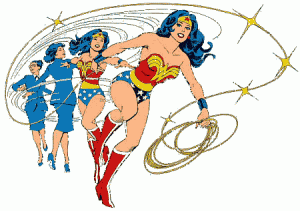 Wonder Woman
Wonder Woman
 “Gest” is not supposed to mean gesticulation: it is not a matter of explana-tory or emphatic movements of the hands, but of overall attitudes. A language is gestic when it is grounded in a gest and conveys particular attitudes adopted by the speaker towards other men. The sentence “pluck the eye that offends thee out” is less effective from the gestic point of view than “if thine eve offend thee, pluck it out.” The latter starts by pre-senting the eye, and the first clause has the definite gest of making an assumption; the main clause then comes as a surprise, a piece of advice, and a relief.
“Gest” is not supposed to mean gesticulation: it is not a matter of explana-tory or emphatic movements of the hands, but of overall attitudes. A language is gestic when it is grounded in a gest and conveys particular attitudes adopted by the speaker towards other men. The sentence “pluck the eye that offends thee out” is less effective from the gestic point of view than “if thine eve offend thee, pluck it out.” The latter starts by pre-senting the eye, and the first clause has the definite gest of making an assumption; the main clause then comes as a surprise, a piece of advice, and a relief.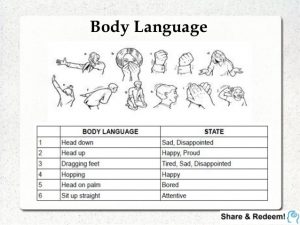 Suppose that the musician composing a cantata on Lenin’s death has to reproduce his own attitude to the class struggle. As far as the gest goes, there are a number of different ways in which the report of Lenin’s death can be set. A certain dignity of presentation means little, since where death is involved this could also be held to be fitting in the case of an enemy. Anger at ‘the blind workings of providence’ cutting short the lives of the best members of the community would not be a communist gest; nor would a wise resignation to “life’s irony”; for the gest of communists mourning a communist is a very special one. The musician’s attitude to his text, the spokesman’s to his report, shows the extent of his political, and so of his human maturity. A man’s stature is shown by what he mourns and in what way he mourns it. To raise mourning to a high plane, to make it into an element of social progress: that is an artistic task.
Suppose that the musician composing a cantata on Lenin’s death has to reproduce his own attitude to the class struggle. As far as the gest goes, there are a number of different ways in which the report of Lenin’s death can be set. A certain dignity of presentation means little, since where death is involved this could also be held to be fitting in the case of an enemy. Anger at ‘the blind workings of providence’ cutting short the lives of the best members of the community would not be a communist gest; nor would a wise resignation to “life’s irony”; for the gest of communists mourning a communist is a very special one. The musician’s attitude to his text, the spokesman’s to his report, shows the extent of his political, and so of his human maturity. A man’s stature is shown by what he mourns and in what way he mourns it. To raise mourning to a high plane, to make it into an element of social progress: that is an artistic task.